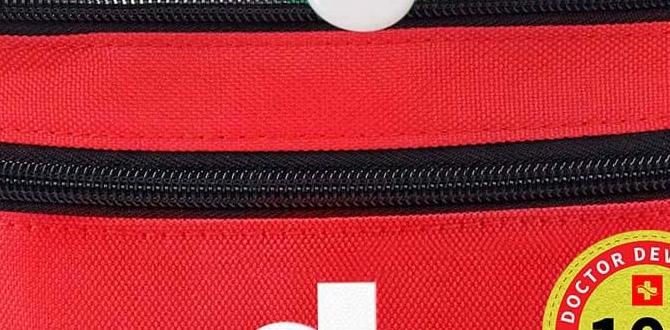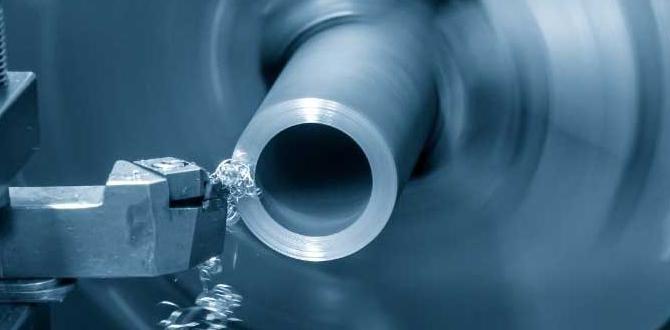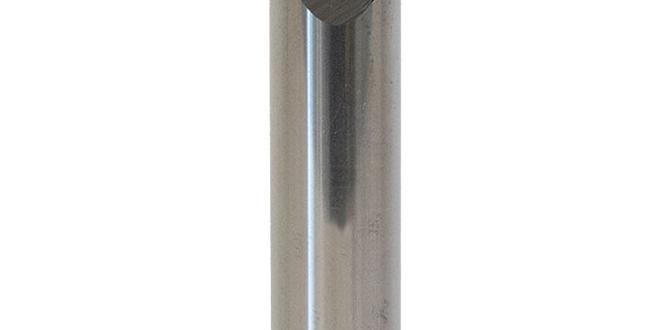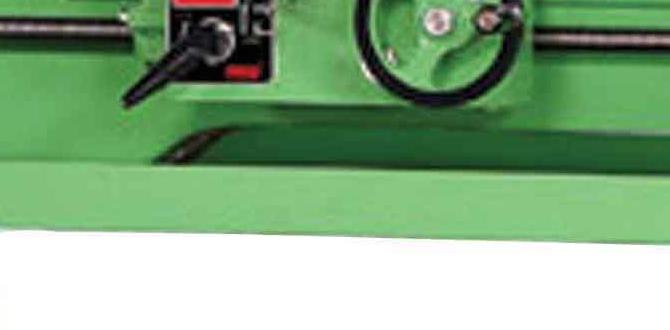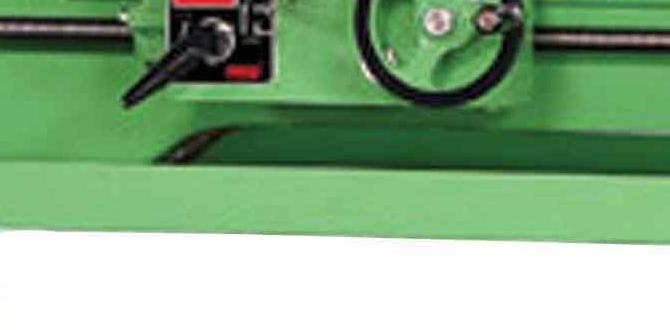Quick Summary: For cast iron, a face mill offers faster material removal and a better surface finish, ideal for larger areas. A fly cutter is simpler, cheaper, and perfect for shallow facing or small parts, though it cuts slower and can leave a slightly rougher finish. Choose based on project needs and budget.
Hey there, fellow makers! Daniel Bates here from Lathe Hub. Ever stared at a rough casting of cast iron, wondering which tool is the right one to get it perfectly flat? It’s a super common question when you’re getting into milling, and honestly, it can be a bit confusing at first. Both face mills and fly cutters can flatten metal, but they do it in very different ways. Getting it wrong can mean wasted time, a ruined part, or a finish you’re not happy with. Don’t worry, though! We’re going to break down exactly what each tool does, how they compare, and when to use them, especially when machining that tricky stuff like cast iron. Stick around, and we’ll get your cast iron projects looking smooth and professional in no time!
Understanding Your Tools: Face Mill vs. Fly Cutter
When you’re looking to achieve a nice, flat surface on a piece of metal, especially something like cast iron, two primary tools often come to mind for milling machines: the face mill and the fly cutter. They might look a little similar from afar – both spin and have cutting edges – but their design, operation, and effectiveness are quite different. Think of them as two different tools in your toolbox, each with its own specialty. We’ll dive into what makes them tick.
What is a Face Mill?
A face mill is a rotating cutting tool designed to machine the flat surfaces of a workpiece. Imagine a large disc, often with multiple inserts (little replaceable cutting teeth) positioned around its perimeter and sometimes on its face. When it spins, these inserts shear off material from the top surface of your workpiece, leveling it out. They are robust, efficient, and capable of removing a significant amount of material quickly.
Here’s a closer look at what defines a face mill:
- Multiple Cutting Edges: The most defining feature is the presence of several cutting inserts. This allows it to take a wider cut and remove material much faster than a single-point tool.
- Insert Technology: Modern face mills typically use indexable carbide inserts. These are pre-shaped cutting tools that can be rotated or replaced when worn, offering excellent performance and being economical in the long run.
- Rigidity and Stability: Due to their design and often heavier construction, face mills are generally very rigid. This means they can handle higher cutting forces without chatter or vibration, leading to a better finish.
- Versatility: Depending on the type of inserts used, face mills can be excellent for roughing (heavy material removal) and finishing (achieving a smooth surface).
What is a Fly Cutter?
A fly cutter, on the other hand, is a much simpler device. At its core, it’s a single tool holder that extends from a central body, armed with a single cutting tool (usually a piece of high-speed steel (HSS) or a carbide insert). As it spins, this single cutter sweeps out a circle, generating a flat surface. It’s like a one-armed bandit of the milling world!
Let’s break down the fly cutter:
- Single Cutting Edge: The key difference is the single cutter. This means material removal is much slower compared to a face mill because only one point is doing the work at any given time.
- Simplicity: Fly cutters are generally much simpler in design and construction. They can be homemade or purchased as relatively inexpensive tools.
- Adjustability: The cutting tool in a fly cutter can usually be adjusted radially outward or inward. This allows you to change the diameter of the cut and also to keep the tool sharp by advancing it slightly.
- Shallow Cuts: They are best suited for relatively shallow cuts and light material removal. Trying to hog off too much material with a fly cutter can lead to chatter and poor results.
Face Mill vs. Fly Cutter for Cast Iron: The Showdown
Now that we know what each tool is, let’s put them head-to-head, specifically for cast iron. Cast iron can be a bit of a chore to machine – it’s brittle, can have hard spots, and generates abrasive dust. These characteristics really highlight the strengths and weaknesses of each tool.
Material Removal Rate (MRR)
This is about how quickly you can remove metal. When it comes to MRR, the face mill is the clear winner. With its multiple cutting edges working simultaneously, it can sheer off a large volume of material in a single pass. This is crucial when you have a casting that’s significantly out of flat or needs a substantial amount of material removed to achieve the desired dimensions. You’ll get the job done much faster.
The fly cutter, with its single cutting edge, is significantly slower. Each revolution of the tool removes a thin sliver of material. If you have a lot of material to remove, using a fly cutter will take a very long time and can even put excessive strain on your machine spindle if you try to rush it.
Winner: Face Mill
Surface Finish
This is about how smooth the resulting surface will be. For cast iron, a good surface finish is often desired to reduce friction and improve aesthetics. A well-maintained face mill, especially one with sharp, good-quality inserts, can leave an exceptionally smooth finish. The overlapping cuts from multiple inserts help to blend the surface together. High-quality finishing inserts can even produce a mirror-like finish.
A fly cutter can achieve a decent finish, but it’s often not as smooth as a face mill. Because it’s a single point of contact making a sweeping cut, you might notice distinct, fine circular lines from the cutter’s path. This is sometimes called a “swirl” finish. While acceptable for many applications, it might require a secondary finishing operation if a very smooth surface is critical.
Winner: Face Mill (for best possible finish)
Tooling Cost and Complexity
When you’re starting out or on a tight budget, tool cost is a big factor. Fly cutters are generally much cheaper to acquire. You can often buy a good quality one for less than the cost of a single carbide insert for a decent face mill. Furthermore, they are simpler to set up and use. Less complexity means less can go wrong during setup.
Face mills, on the other hand, can be a significant investment. A good quality face mill body can be expensive, and then you have the cost of the inserts. While inserts are replaceable, they are still a consumable item that adds to the ongoing cost of machining. The setup can also be a bit more involved, ensuring the inserts are correctly seated and the overall balance is good.
Winner: Fly Cutter
Machine Requirements and Rigidity
Machining cast iron with a face mill requires a reasonably rigid milling machine. The forces involved can be substantial, and if your machine has a lot of play in its ways or a weak spindle, you’ll experience chatter, vibration, and poor results. For cast iron, a machine with good rigidity is essential for effective face milling.
A fly cutter is much more forgiving on machine rigidity. Because it removes material in lighter passes, it can be used effectively on smaller, less rigid milling machines, or even on some drill presses equipped with milling attachments. This makes it a great option for hobbyists with limited machine capabilities.
Winner: Fly Cutter (for less rigid machines)
Setup and Ease of Use
For beginners, the fly cutter often wins in terms of ease of use. Mounting it is straightforward, and adjusting the cutter to achieve the desired diameter is usually simple. You just need to make sure the cutter is locked securely and set to the correct height.
Setting up a face mill can be a bit more involved. You need to ensure all inserts are properly seated and torqued, and that the overall balance of the tool is good, especially at higher RPMs. Improper setup can lead to poor surface finish, insert breakage, or even damage to the machine.
Winner: Fly Cutter
When to Use a Face Mill for Cast Iron
Given its capabilities, a face mill is the tool of choice for several scenarios when working with cast iron:
- Large Surfaces: When you need to flatten a large area, like the base of a machine tool or a significant casting, a face mill is far more efficient.
- Heavy Material Removal: If your cast iron part has a lot of excess material, warpage, or rough surfaces that need significant cleanup, a face mill will get the job done faster and more effectively.
- High-Volume Production: In a production environment where speed and efficiency are paramount, face mills are indispensable for their high MRR.
- Superior Surface Finish: If your project demands a very smooth, precise flat surface, a face mill with the right inserts will deliver better results than a fly cutter.
- Rigid Machinery: When you have a sturdy, rigid milling machine capable of handling the cutting forces, a face mill can be used to its full potential.
Example Scenario: Machining a Lathe Base Plate
Imagine you’ve just received a raw casting for a new lathe machine base plate. It’s rough, has casting skin, and isn’t perfectly flat. You need a perfectly parallel and smooth surface for mounting other machine components. This is a prime candidate for a large face mill. You’d mount the face mill, set your depth of cut to address the imperfections, and with a few passes, you’d have a beautifully flat and smooth surface ready for the next steps. Trying to do this with a fly cutter would take an immense amount of time and likely result in a less-than-ideal finish for such a critical component.
When to Use a Fly Cutter for Cast Iron
Don’t count out the fly cutter! It has its own niche, especially for hobbyists and smaller jobs.
- Shallow Facing Operations: When you only need to remove a small amount of material to achieve flatness or to lightly skim a surface, a fly cutter is perfect.
- Small Parts or Small Areas: For machining small components or just part of a larger surface, a fly cutter can be more practical and cost-effective.
- Budget Constraints: If you’re on a tight budget for tooling, a fly cutter is a great way to achieve facing capabilities without a large investment.
- Less Rigid Machines: On drill presses set up for milling or less robust milling machines, a fly cutter allows you to perform facing operations without overstressing the equipment.
- Making Custom Cutters: Some machinists enjoy making their own fly cutters, customizing them for specific tasks.
- Simple Depth Adjustments: When you need to precisely control the depth of a shallow cut across a surface.
Example Scenario: Machining a Fixture Plate
Consider a small fixture plate you need to make for your workshop. It’s a piece of aluminum or mild steel (or even a smaller cast iron piece) where you need to drill precise holes. You decide to face off one side to ensure it sits perfectly flat against whatever it will be mounted to. For this relatively small area and likely shallow cut, a fly cutter is ideal. It’s quick to set up, doesn’t require a massive machine, and does the job efficiently.
External Resource: For more on machining fluids, which are crucial for cast iron to reduce heat and clear chips, check out the role of machining fluids in metal cutting.
Key Differences Summarized in a Table
To make it crystal clear, here’s a table laying out the side-by-side comparison:
| Feature | Face Mill | Fly Cutter |
|---|---|---|
| Cutting Edges | Multiple (Inserts) | Single (HSS or insert) |
| Material Removal Rate (MRR) | High | Low |
| Surface Finish | Very good to excellent | Good, can have swirl marks |
| Tooling Cost | High initial cost, ongoing insert cost | Low initial cost, simple cutter replacement |
| Machine Requirements | Requires rigid, powerful machine | Suitable for less rigid machines, drill presses |
| Setup Complexity | Moderate to High | Low |
| Ideal For | Large areas, heavy material removal, fine finishes | Small areas, shallow cuts, budget projects |
Tips for Machining Cast Iron
Machining cast iron, whether with a face mill or a fly cutter, requires some specific considerations to ensure success and safety. Here are a few key tips:
- Use Cutting Fluid: Cast iron can be abrasive and generate a lot of heat. Using a good quality cutting fluid or coolant will help lubricate the cut, cool the tool and workpiece, and flush away chips. Dry machining cast iron is generally not recommended as it can quickly dull tools and lead to poor surface finishes.
- Manage Chips: Cast iron chips can be brittle and break into small pieces, creating dust. This dust is messy and can be a respiratory hazard. Ensure good chip evacuation from the cutting area, and wear appropriate personal protective equipment (PPE), especially a respirator.
- Appropriate Speeds and Feeds: Cast iron is not as forgiving as softer metals like aluminum. You’ll generally want to run slower spindle speeds (RPMs) and use moderate feed rates. Too fast, and you risk chipping inserts or damaging your tool. Consult tool manufacturer guidelines for specific recommendations. A good starting point for cast iron with carbide tooling might be around 200-400 SFM (Surface Feet per Minute) for face mills and significantly slower for HSS fly cutters.
- Cleanliness is Key: Keep your machine clean. Cast iron dust can get into everything. Regularly clean your table, ways, and chip trays. This not only protects your machine but also helps in managing the mess.
- Sharp Tools: Always use sharp cutting tools. Dull tools will chatter, generate excessive heat, and leave a poor finish. For fly cutters, this means ensuring your HSS cutter is properly ground or that your insert is sharp. For face mills, replace or index worn inserts promptly.
- Secure Workholding: Cast iron can be prone to cracking if clamped improperly. Ensure your workpiece is well-supported and clamped securely but not excessively tightly to avoid inducing stress. Using soft jaws or aluminum shims can help protect the surface.
External Resource: For detailed safety guidelines in machining environments, the Occupational Safety and Health Administration (OSHA) provides valuable information on metalworking machinery safety.
Frequently Asked Questions (FAQ)
What is the primary difference between a face mill and a fly cutter?
The main difference is the number of cutting edges. A face mill uses multiple inserts for aggressive material removal, while a fly cutter uses a single cutter for lighter cuts. This impacts speed, finish, and cost.
Can I use a fly cutter on a drill press?
Yes, many fly cutters are designed to be used on drill presses equipped with a milling vise or suitable fixturing. However, they are best for light skimming and cannot remove large amounts of material like a dedicated milling machine can.
Which tool is better for making initial setup cuts on raw castings of cast iron?
For raw castings with significant surface irregularities, a face mill is generally better due to its higher material removal rate and ability to flatten large areas quickly.
How do I prevent chatter when fly cutting cast iron?
To prevent chatter, ensure the cutter is sharp, take light cuts, use a slow spindle speed, and maintain a steady feed rate. A rigid setup is also crucial. For fly cutters, ensure the tool holder is firmly seated and the cutter is securely locked.
Are carbide inserts necessary for face milling cast iron?
While you could use high-speed steel (HSS) inserts, carbide inserts are highly recommended for face milling cast iron. They are much harder and more resistant to wear and heat, providing significantly better performance and tool life.
<div class=”faq-section

